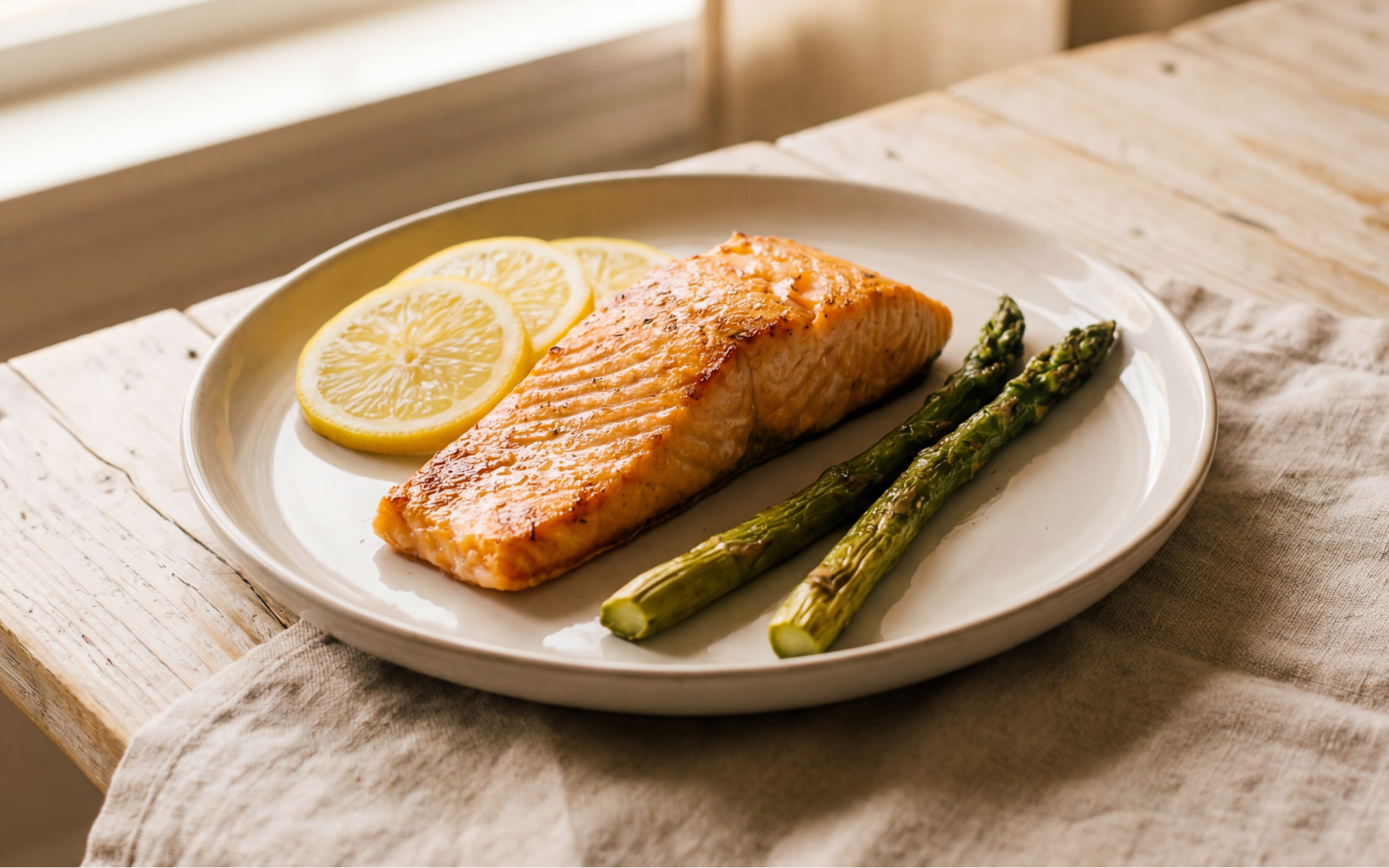Ayurvedic Diet
If you are struggling a bit with what to eat, when, and how, then Ayurvedic diet offers immense knowledge on the best way to balance your body, mind, and spirit. This diet originated in India thousands of years ago. It works alongside yoga to promote an all-around wellness and prevent any imbalance, which can result in a slew of ailments. Use this comprehensive post to know more about the Ayurvedic diet, how it works, foods to eat and avoid as well as pros and cons.
Get your personalized
meal plan!
What Is An Ayurvedic Diet?
Ayurvedic diet is an eating plan based on Ayurvedic medicine. This holistic approach applies the concepts of three doshas: Vata, Pitta, and Kapha.
1. Vata (Air and space)
Of the three doshas, Vata is the most powerful as it’s associated with the nervous system and anything related to circulation, assimilation of food, breathing, and muscle movement. This body type is disrupted by grief, fear, and eating too soon after a meal. Anxiety, constipation, and skin problems are some of the signs of Vata imbalance.
2. Pitta (Fire and water)
Pitta dosha is responsible for body temperature, metabolism, digestion, nutrition, and assimilation. It is aggravated by food that is too spicy or acidic. Common signs of pitta imbalance include muscle fatigue, fever, sensitivity to spicy food, inflammation, diarrhea, skin irritations, excessive thirst, nausea, and low blood sugar.
Read More: Pitta Diet To Kick Your Metabolism Up A Notch
3. Kapha (Water and earth)
This dosha is responsible for muscle growth, weight, and stability. Its function is related to the immune and lymphatic system. Hence it’s disrupted by a diet rich in processed foods and drinks, especially those containing excess water and salt. When out of balance, Kapha body types experience sinus congestion and slow digestion that increases the risk of obesity.
These three types of energies constitute the physical body, spirit, and mental wellbeing. Each element commands a specific body function, and together they determine various conditions such as health, aging, diseases, and growth.
How It Works
Based on the principals of this diet, when the body, mind, and spirit are in harmony with the universe, it results in a desire to eat healthy food. An imbalance caused by age, injuries, stress, dehydration, changes in seasons, climate, or emotions results in an unhealthy body and mind. Therefore, for Ayurvedic diet to work, you have to eat according to your dosha and focus on meals that promote a healthy inner balance.
A deficiency or excess of Kapha, Vata, or Pitta also affects overall well-being. Since Ayurvedic is a complementary and alternative medicine, it can be used alongside other holistic approaches such as yoga and meditation.
Ayurvedic lifestyle provides dietary solutions geared towards preventing specific health problems and uncovering its root causes.
If you’re feeling out of balance, taking a dosha quiz or talking to a professional will help you understand your Ayurvedic body type. After that, you’ll acquire accurate information on the necessary steps to take to ensure optimal health.
Whether you’re a workout beast or just a beginner making your first foray into the world of fitness and dieting – BetterMe has a lot to offer to both newbies and experts! Install the app and experience the versatility first-hand!
Foods To Eat
When it comes to the foods specified in the Ayurvedic diet, it’s recommended to eat foods that stimulate the six tastes: sweet, sour, bitter, astringent, pungent, and salty. This is because each taste has a unique relationship with a specific dosha.
For instance, while a Pitta person prefers sweet flavors, an overload of sweet foods creates a Kapha imbalance. Therefore, after identifying your dominant dosha, use the Ayurveda food guidelines to develop meal plans that nourish your body and keep your energy balanced (3).
Ayurveda diet recipes recommend the inclusion of fruits, grains, vegetables, spices, legumes, dairy, condiments, meat from animals, nuts, seeds, oils, herbal teas, sweeteners, and beverages. Some of the specific foods that each dosha should eat and those to avoid are listed below.
Vata Foods To Eat
- Most sweet fruits such as bananas, apricots, fresh dates, apples, mangoes, and papayas.
- Most dairy: Buttermilk, butter, cottage cheese, and milk.
- Animal foods: Beef, chicken, eggs, duck, buffalo, and seafood.
- All spices: Bay leaf, black pepper, cardamom, cinnamon, cumin, and coriander.
- Legumes: Lentils, soy, and beans.
- Grains: Cooked oats, quinoa, rice, wheat, and bread.
- Sweeteners: Honey, jaggery, sugar cane juice, fructose, and barley malt.
- Oils: Ghee, olive, and sesame.
- Seeds: Chia, flax, sunflower, pumpkin, and sesame.
- All nuts should be taken in moderation.
- Beverages: Apple cider, apricot juice, chai, aloe Vera juice, and almond milk.
Vata Foods To Avoid
- Grains: Barley, cold or dry cereals, corn, crackers, granola, pasta and oat bran.
- Legumes: Black beans, chickpeas, brown lentils, soy powder and soy beans.
- Dairy: Powdered milk and plain or frozen yogurt.
- Meat: Pork, rabbit, white turkey and lamb.
- Seeds: Popcorn and psyllium.
- Oils: Flax seeds.
- Dried fruits.
- Frozen, dried or raw vegetables.
Pitta Foods To Eat
- Sweet and bitter vegetables: Broccoli, asparagus, artichoke, cabbage, cooked carrots, tomatoes, cauliflower, and cucumber.
- Grains: Granola, cereal, pasta, oat bran, and pancakes.
- Meat: Buffalo, beef, duck, sea fish, pork, lamb, salmon, and sardines.
- Spices: Basil, coriander, black pepper, fennel, cumin, mint, and ginger.
- Oils: Sunflower, ghee, canola, olive, and flax seeds.
- Seeds: Flax, Halva, Psyllium, sunflower, and popcorn.
- Dairy: Cow milk, ice cream, ghee, unsalted butter, goat milk, and cheese.
- Legumes: Kidney beans, chickpeas, red and brown lentils.
- Nuts: Almonds, coconut, and charole.
Pitta Foods To Avoid
- Grains: Corn, millet, dry oats, brown rice, rye, and buckwheat.
- Legumes: Soy, miso and soy sauce.
- Dairy: Salted butter, hard cheese, buttermilk, sour cream, and plain or frozen yogurt.
- Animal foods/meat: Duck, egg yolk, seafood, beef, pork, and dark turkey.
- Nuts: Walnuts, cashews, almonds with skin, macadamia, peanuts, pistachios and pecans.
- Seeds: Sesame, Tahini and chia.
- Oils: Corn, almond, sesame, safflower, and apricot.
- Spices: Ajwan, bay leaf, cloves, garlic, dry ginger, nutmeg, oregano, and paprika.
- Pungent vegetables.
- Most sour fruits.
Kapha Foods To Eat
- Oils: Canola, ghee, sunflower, and corn.
- Most pungent and bitter vegetables: Artichoke, bitter melon, beet greens, sprouts, and Brussels
- Most astringent fruits: Apples, apricots, berries, cherries, pears, raisins, and pomegranate.
- Grains: Barley, buckwheat, corn, millet, dry oats, rye, and rice.
- Legumes: Black-eyed peas, red lentils, black beans, lima beans, peas, and soy.
- Dairy: goat cheese, diluted yogurt, and cottage cheese.
- Meat/animal foods: Rabbit, eggs, fish, white turkey, and chicken.
- Nuts: Charole.
- Seeds: Chia, and popcorn.
- Oils: Corn, canola, ghee, almond, and sesame.
- Spices: All spices including Ajwan, Basil, Bay leaf, and Cayenne.
Dropping pounds by the dozens without putting yourself through the wringer is everyone’s weight loss pipe dream. But what if we told you that the BetterMe app can make that happen? Keep yourself in prime shape with our fat-blasting workouts, delicious budget-sparing recipes, and body-transforming challenges with our app!
Kapha Foods To Avoid
- Spices: Salt
- Oils: Avocado, coconut, apricot, olive, safflower, sesame and flax seeds.
- Seeds: Halva, sesame, tahini and psyllium.
- Nuts: Pecans, Macadamia, pine nuts, walnuts, coconut, cashews, pistachio and peanuts.
- Dairy: salted and unsalted butter, cheese, ice-cream, sour cream and cow’s milk.
- Meats: Beef, buffalo, lamb, pork, salmon, dark turkey, and tuna fish.
- Legumes: Kidney beans, soy sauce, miso, cold tofu and soy beans.
- Grains: Pasta, rice cakes, wheat, rice, oats and bread with yeast.
- Most sweet and sour fruits
- Sweet juicy vegetables
To savor the taste and enjoy the diversity of flavors, you have to eat slowly yet quickly enough such that the meal doesn’t get cold. The right food quantities also play a vital role in the overall well-being.
Pros Of Ayurvedic Diet
Listed below are the benefits of this diet.
Weight Management
Can Ayurveda help you lose weight? Ayurvedic diet for weight loss is possible since it encourages healthy balanced meal plans and physical activity. It also advocates for unprocessed and nutrient-rich whole foods, which leaves less room for a high calorie diet. Whole foods are also rich in fiber, healthy fats and on top of that they help in cutting down calories (5).
While there is little scientific evidence behind the favoring and avoiding of foods based on dosha, recent research shows that nutrient-dense foods and those rich in fiber, which are generally encouraged by the Ayurvedic diet, help in weight management (7). Furthermore, it has been demonstrated that when combined with yoga, Ayurveda lifestyle can result in weight loss (1).
Promotes Well-Being
Good nutrition, coupled with the right exercise is essential for a healthy well-rounded life. Since Ayurvedic detox diet involves paying attention to what you eat, it encourages a healthy relationship with food and promotes overall well-being. Besides, research shows that mindful eating can help solve a wide range of health problems (4).
Improves Overall Health
This diet requires the dieter to make good food choices. Apart from helping to maintain a healthy weight, healthy diets like this one may also reduce the risk of diseases and increase life expectancy (2).
Read More: How To Start A Healthy Lifestyle: Simple Habits To Kick-Start A Healthier Lifestyle
Cons Of Ayurvedic Diet
Determination Of Dosha Is Hard
While there are quizzes that one can use to find out their dominant dosha, in most cases, it’s hard to get accurate results. Some people may also have more than one body type, which further complicates the selection process.
Limited Food Choices Make It Hard To Stick To The Rules
For the diet to work, you have to eat specific foods and avoid others. For example, Ayurvedic diet pitta includes dry grains to avoid offsetting the oily nature of this body type.
The Ayurvedic diet plan also has more rules to follow, such as those for tastes, and some of the mentioned foods may not be in season. All the principals might be confusing for someone who is just embarking on a health journey. That is why it’s always best to seek professional advice before adopting any eating plan.
Meal Plan (Menu)
Wondering what to eat for breakfast when following Ayurvedic diet or how to start Ayurvedic diet? A typical meal plan for the day should accommodate all the six tastes yet constitute a balanced meal. Kick start digestion with salty, sour, pungent, and bitter components then complete the day by consuming sweet meals, followed by those with an astringent taste.
Breakfast
- Oatmeal or cereal
- A glass of water or juice
- Egg
- Fresh fruit
Lunch
- Spiced chicken, beef or fish
- A small bowl of rice
- Easy to digest vegetables and fruits
Dinner
- Vegetable spiced rice
- Grilled meat
- Fruit
Eat energy-dense foods such as whole grains, seeds, nuts, legumes, fruits, and cooked vegetables but be mindful of the nutrients that work for and against your dosha. If you get hungry, snack on seeds and nuts between the three meals. Overall, eat a moderate breakfast, a satisfying lunch, and a sparing dinner.
It’s without a doubt that unhealthy eating and physical inactivity contribute to the leading causes of death worldwide. This deadly combination is a main culprit for obesity, heart disease, stroke, type 2 diabetes, and cancer (6). Through the Ayurvedic diet, an individual is able to focus on mindful eating of healthy balanced meals based on their dominant dosha.
DISCLAIMER:
This article is intended for general informational purposes only and does not address individual circumstances. It is not a substitute for professional advice or help and should not be relied on to make decisions of any kind. A licensed physician should be consulted for diagnosis and treatment of any and all medical conditions. Any action you take upon the information presented in this article is strictly at your own risk and responsibility!
SOURCES:
- A Pilot Feasibility Study of Whole-systems Ayurvedic Medicine and Yoga Therapy for Weight Loss (2014, ncbi.nlm.nih.gov)
- Can We Say What Diet Is Best for Health? (2014, pubmed.ncbi.nlm.nih.gov)
- FOOD GUIDELINES (2016, ayurveda.com)
- Mindful eating (2011, health.harvard.edu)
- Poor diet biggest risk factor for early deaths worldwide (2019, medicalnewstoday.com)
- The Whole Foods Diet (2006, webmd.com)
- What are the best foods for weight loss? (2018, medicalnewstoday.com)

















